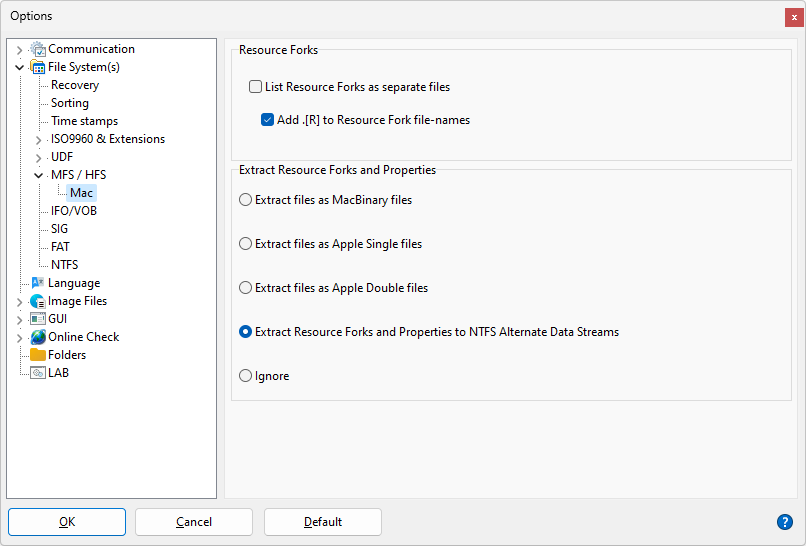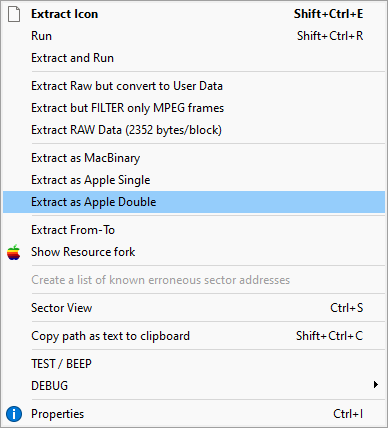Apple Mac-Dateien und -Ordner extrahieren
Apple Mac Dateien bestehen gewöhnlicherweise aus zwei physikalischen Dateien, dem Datenzweig (Data Fork) und dem Ressourcenzweig (Resource Fork).
Diese beiden Dateien haben einen identischen Dateinamen und werden unter Mac OS als eine Datei angezeigt.
Dies führt unter Windows Systemen zu problemen, da zwei identische Dateinamen in einem Ordner nicht erlaubt sind.
IsoBuster zeigt diese als kombinierte Dateien an, also als eine Datei, welche beim extrahieren mittels IsoBuster so extrahiert wird, dass Windows diese Datei/Dateien verarbeiten kann.
Im Falle, dass diese Dateien später in ein Mac System zurückgespielt werden sollen, ist zu beachten, dass Mac dieses Format von sich aus verarbeiten kann, jedoch kann die automatische Dateiverknüpfung zu diesem Programm verlorengehen. Wenn die Datei beispielsweise ein Word Dokument ist, und man klickt diese Datei dann unter Mac OS an, wird eventuell der Word Editor nicht mehr gestartet.
Dennoch kann man das Dokument manuell über die Funktion "Öffnen" des Word Editors laden und weiterarbeiten.
Extrahieren von Dateien als MacBinary dateien
Wenn Sie die Dateien jedoch als MacBinary-Dateien extrahieren, kombiniert IsoBuster die beiden Forks zu einer (*.bin)-Datei gemäß einem bestehenden Standard, dem MacBinary-Standard. Die resultierenden Dateien sind unter Windows nicht nützlich, und Sie sollten nicht als MacBinary-Dateien extrahieren, wenn Sie die Dateien auf einem Windows-System verwenden möchten. Wenn Sie die Dateien jedoch per E-Mail, Netzwerk oder ähnlichem auf einen Mac übertragen möchten, kann das Extrahieren als MacBinary-Dateien nützlich sein. Für Mac gibt es mehrere Programme, die MacBinary-Dateien verarbeiten können und die beiden Forks aus einer einzigen MacBinary-Datei wiederherstellen können. Stuffit Expander macht dies beispielsweise.
Extrahieren von Dateien als Apple Single dateien
Wie bei MacBinary, jedoch nach einem anderen Standard. Es wird eine einzelne Datei erstellt, die einen Header mit Finder-Informationen enthält, gefolgt vom Resource Fork und dem Data Fork. Die resultierende Datei hat denselben Namen wie die Originaldatei.
[Eingeführt in IsoBuster 5.2]
Extrahieren von Dateien als Apple Double dateien
Wie bei Apple Single, jedoch wieder nach einem leicht anderen Standard. Es werden zwei Dateien erstellt: der Data Fork und eine zusätzliche Datei, die einen Header mit Finder-Informationen enthält, gefolgt vom Resource Fork. Die zusätzliche Datei hat fast denselben Namen wie der Data Fork, beginnt jedoch immer mit: "._". Zum Beispiel, wenn Sie die Datei „Icon“ extrahieren, werden zwei Dateien erstellt: eine mit dem Namen „Icon“ und eine mit dem Namen „._Icon“. PS: Die zusätzliche ._* Datei wird auch für Ordner erstellt.
[Eingeführt in IsoBuster 5.2]
Global
(Nur) MFS und HFS Dateisysteme verfügen über eine globale Einstellung, bei der Sie eine der oben genannten Extraktionsmethoden auswählen können.
Nach der Auswahl wird die normale (Benutzerdaten-)Extraktion stets automatisch durch die global gesetzte Extraktionsmethode ersetzt.
Andere Extraktionsmethoden bleiben unverändert.

Über Rechtsklick
Für Dateien, Ordner und Dateisysteme, die Apple Mac Finder-Info und/oder Resource Forks enthalten, können die oben genannten Extraktionsmethoden über einen Rechtsklick (auf die Datei, den Ordner oder das Dateisystem) ausgewählt werden.
Dies gilt immer für MFS und HFS. Für ISO9660 (und Derivate wie Joliet), UDF und NTFS sind diese Extraktionsmethoden nur verfügbar, wenn Finder-Info und/oder Resource Forks erkannt werden.
